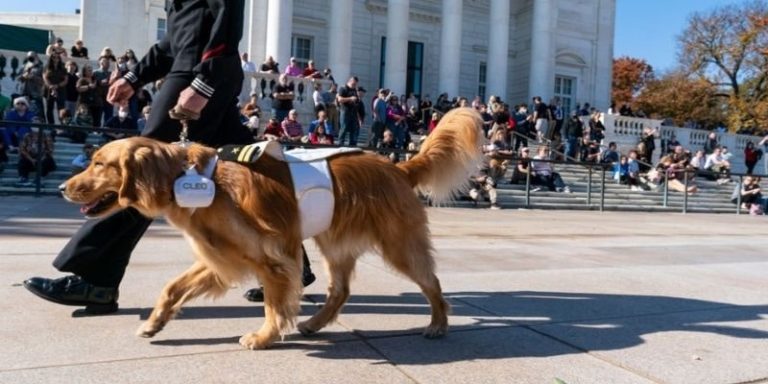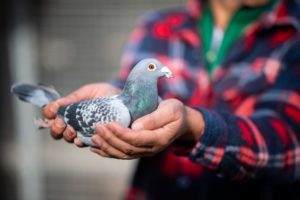Veteran Animals – Helping Humans on the Battlefield
Over the years, animals have played a major role in warfare.
By: Kirsten Brooker | November 11, 2022 | 742 Words

(Photo by Alex Brandon-Pool/Getty Images)
Veterans day is a time to honor the people who have served their country in the military, but what about the heroic efforts of those that are not human? Important roles conducted by birds, horses, dogs, and other species changed how battles were fought. For example, horses, mules, camels, and other large animals helped to carry items and soldiers. Dogs would sniff out danger, and birds would relay important messages.
President Wilson – The Carrier Pigeon
Carrier pigeons were helpful during World War I and World War II. The birds would deliver important messages between commanders and troops. They were more dependable than telephones and telegraphs as the technology was still relatively new.

(Photo by Sebastian Gollnow/picture alliance via Getty Images)
A pigeon named President Wilson is titled a hero for a flight he made under intense gunfire, during which he sustained several injuries. Yet, unbelievably, Wilson completed the essential 25-mile mission before he was transported to a facility where he received the care he needed. He lived eleven more years at the US Army Signal Corps Breeding and Training Center at Fort Monmouth, New Jersey. The courageous bird is now preserved by taxidermy and placed in the halls of the US military headquarters in Lexington, Virginia, to be forever honored as a military war hero.
Equine Heroes
Horses have been a crucial part of many historical battles. Many countries have had cavalry regiments, including the United States. Cavalry warfare was common until World War II, but this largely ended in the 1940s as nations turned toward machines and technology. The large animals are strong, fast, intelligent, and dependable, making them especially helpful in war settings. However, horses can be very temperamental and tend to scare easily, so it took special breeding and training to prepare them for battle.
Colonel Bob Ferrer, an equestrian and fox hunter, explained how warhorses differ from traditional equine. He said:
“Warhorses are trained to perform to easy and light commands, and to be less responsive to the reins than to the legs and the hips of a rider, who often had to otherwise have his hands available to engage his arms with a sword or a gun. Entering into battle on a horse is considerably different than going into battle on foot because you have to make sure that your horse can stand when fired at. Smoke and noise will frighten a horse. They are herd animals and they have to be brave enough not to turn and run when another – say a horse ridden by your foe – gets scared and dashes off in one direction.”
George Washington used horses to survey large areas of land, hunt foxes, and fight in battles. Combat on horseback gave Washington the speed and agility to maneuver through dangerous territory and avoid gunfire by dodging the bullets and fire aimed in his direction.
Other species, like camels, elephants, and mules, have also played similar roles in warfare.
Famous Military Dogs
Dogs today are known to provide emotional support, protection, and friendship. Houses across America are often home to a beloved dog or two. In battle, dogs served much the same purpose. Not only were they great support and fun for the soldiers who faced misery day in and day out, but they also were brave and agile enough to scope out dangerous situations. In doing so, the man’s best friend saved countless lives.
In World War I, a dog named Sergeant Stubby was the only canine to move up in the ranks and earn the title of sergeant. Stubby was a Boston Terrier mix and served as a protector, a missing soldier locator, and an alarm service when danger arose. The heroic pup earned several medals and even met a few presidents in honor of his deeds on the battlefield.
During World War II, Smoky, a four-pound Yorkshire Terrier, hitched a ride in the backpack of Corporal William A. Wynne. Though small, Smoky proved to be a remarkable addition to the 5th Air Force. He served as a therapy dog and used his small stature to run a telegraph line through a 70-foot pipe in just minutes, a feat that would have taken three days for the engineers to complete.
Dogs and other animals have loyally and unselfishly fulfilled human needs for many years. Without those courageous creatures, our lives and history could look very different today.
















